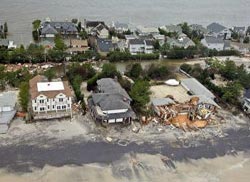Climate change threatens to cause trillions in damage to world's coastal regions

Aerial views during an Army search and rescue mission show damage from Hurricane Sandy to the New Jersey coast, Oct. 30, 2012<br><br>Credit: US Air Force photo by Master Sgt. Mark C. Olsen<br>
According to the study published in the Proceedings of the National Academy of Sciences, global average storm surge damages could increase from about $10-$40 billion per year today to up to $100,000 billion per year by the end of century, if no adaptation action is taken.
The study, led by the Berlin-based think-tank Global Climate Forum (GCF) and involving the University of Southampton, presents, for the first time, comprehensive global simulation results on future flood damages to buildings and infrastructure in coastal flood plains. Drastic increases in these damages are expected due to both rising sea levels and population and economic growth in the coastal zone. Asia and Africa may be particularly hard hit because of their rapidly growing coastal mega-cities, such as Shanghai, Manila and Lagos.
“If we ignore this problem, the consequences will be dramatic,” explains Jochen Hinkel from GCF and the study's lead author. In 2100, up to 600 million people (around 5 per cent of the global population) could be affected by coastal flooding if no adaptation measures are put in place.
“Countries need to take action and invest in coastal protection measures, such as building or raising dikes, amongst other options,” urges Hinkel. With such protection measures, the projected damages could be reduced to below $80 billion per year during the 21st century. The researchers found that an investment level of $10 to $70 billion per year could achieve such a reduction. Prompt action is needed most in Asia and Africa where, today, large parts of the coastal population are already affected by storm surge flooding.
However, investment must also occur in Europe as shown by the recent coastal floods in South West England. Professor Robert Nicholls from the University of Southampton, who is a co-author of the paper, says: “If we ignore sea-level rise, flood damages will progressively rise and presently good defences will be degraded and ultimately overwhelmed. Hence we must start to adapt now, be that planning higher defences, flood proofing buildings and strategically planning coastal land use.”
Meeting the challenge of adapting to rising sea levels will not be easy, explains Hinkel: “Poor countries and heavily impacted small-island states are not able to make the necessary investments alone, they need international support.” Adding to the challenge, international finance mechanisms have thus far proved sluggish in mobilising funds for adapting to climate change, as the debate on adaptation funding at the recent climate conference in Warsaw once again confirmed.
“If we do not reduce greenhouse gases swiftly and substantially, some regions will have to seriously consider relocating significant numbers of people in the longer run,” adds Hinkel. Yet regardless of how much sea-level rise climate change brings, the researchers say careful long-term strategic planning can ensure that development in high-risk flood zones is appropriately designed or avoided.
Professor Nicholls says: “This long-term perspective is however a challenge to bring about, as coastal development tends to be dominated by short-term interests of, for example, real-estate and tourism companies, which prefer to build directly at the waterfront with little thought about the future.”
Media Contact
More Information:
http://www.soton.ac.ukAll latest news from the category: Earth Sciences
Earth Sciences (also referred to as Geosciences), which deals with basic issues surrounding our planet, plays a vital role in the area of energy and raw materials supply.
Earth Sciences comprises subjects such as geology, geography, geological informatics, paleontology, mineralogy, petrography, crystallography, geophysics, geodesy, glaciology, cartography, photogrammetry, meteorology and seismology, early-warning systems, earthquake research and polar research.
Newest articles

Silicon Carbide Innovation Alliance to drive industrial-scale semiconductor work
Known for its ability to withstand extreme environments and high voltages, silicon carbide (SiC) is a semiconducting material made up of silicon and carbon atoms arranged into crystals that is…

New SPECT/CT technique shows impressive biomarker identification
…offers increased access for prostate cancer patients. A novel SPECT/CT acquisition method can accurately detect radiopharmaceutical biodistribution in a convenient manner for prostate cancer patients, opening the door for more…

How 3D printers can give robots a soft touch
Soft skin coverings and touch sensors have emerged as a promising feature for robots that are both safer and more intuitive for human interaction, but they are expensive and difficult…




















